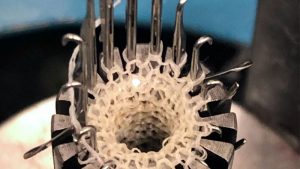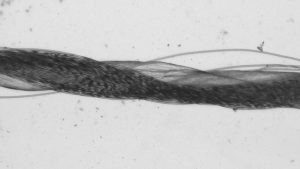
Knitted vascular graft prototype shows promise in preclinical findings.
By Laura Oleniacz
In a proof-of-concept study, Raleigh, N.C.-based North Carolina State University (NC State) researchers reported promising preclinical findings for a prototype of a vascular graft designed as a replacement for a damaged or blocked coronary artery, which supplies blood to the heart.
The findings, which were made in partnership with researchers from Case Western Reserve University, are part of an effort to develop a man-made graft that could replace a damaged or blocked coronary artery when a patient’s own vessels are not available as viable replacements after a heart attack. Ultimately, the graft is designed as a scaffold to aid in regeneration of the patient’s own blood vessels. And while their work is still in early stages, the researchers said their design will help to move the field forward.
In the journal Materials Science and Engineering: C, researchers reported they made their prototype vascular graft by knitting a collagen material with a man-made yarn. They found their design showed improved strength compared to a model that used the collagen material alone, and flexibility that compared to the human coronary artery. Also, in studies with human endothelial cells, they saw increased growth and adhesion of cells on the graft, indicating it could aid in the regeneration of the coronary artery lining.
“We see this as a new direction for research into coronary artery replacement grafts,” said the study’s senior author Martin King, professor of biotextiles and textile technology in the Wilson College of Textiles at NC State. “The use of collagen yarns is very new. We relied not just on one material, but we mixed the materials together and showed the two yarns can provide both mechanical strength and the biological response that we’re looking for.”
Currently, researchers said the “gold standard” is to use a patient’s own blood vessel, such as a vein from the leg or the mammary artery, to replace the coronary artery, but some patients do not have viable blood vessels that can be harvested and used.
“There is a need to find an alternative solution for this kind of patient,” said Fan Zhang, the study’s first author and graduate student at NC State in the Wilson College of Textiles. “That’s why we’re looking to use tissue-engineered vascular grafts.”
There are multiple challenges to designing a synthetic vascular graft that could replace a coronary artery, the researchers said. Some models have failed due to problems with clotting and narrowing of the arteries. Meanwhile, other models aren’t able to stretch and relax with the beating heart.
“The coronary artery is only about three to four millimeters in diameter so it’s a very fine artery, and it’s very easy for it to get blocked,” King said. “The question is: Do we have materials that will serve as a conduit without provoking this clotting on the arterial wall? That is one of the challenges. The other is that the heart is continually expanding and contracting, so we need a structure that can stretch and relax with every heartbeat.”

To develop their design, the NC State investigators collaborated with researchers at Case Western Reserve who have designed a biological yarn made of collagen. They combined that collagen yarn with a man-made fiber made of polylactic acid (PLA), which is biocompatible. When the fiber degrades, it forms lactic acid, researchers said, which is easily tolerated because the muscles in our bodies continuously generate lactic acid.
Researchers said their model is designed to form a temporary scaffold that can regenerate a cell lining similar to the patient’s own blood vessels.
“We’re not designing a prototype that is a ‘final product,’ we’re putting in the ingredients that will allow the patient to heal and use this construct to heal and function as a coronary artery,” King said. “The fibers would eventually degrade and be absorbed into the body.”
Researchers found that by knitting the collagen fibers together with the man-made PLA yarn, human endothelial cells stuck to the scaffold 10 times as much as to the man-made yarn alone. The experiment also showed three times greater cell growth after adhesion.
Also, they found it had excellent bursting strength and compliance, properties that will allow the graft to expand and contract with each heartbeat — similar to a healthy coronary artery.
“We were able to mimic the compliance of the coronary artery,” Zhang said. “This is the most important finding. In addition, with the addition of the collagen yarn component, we were able to promote endothelial cells to grow faster within this structure. That is very important for recovery of the endothelium.”
Their work is still at a preclinical stage and has yet to be tested in a living animal. They still have work to improve their prototype to overcome additional design challenges, including how to reduce the porous nature of the hybrid graft.
However, the team believes their findings show it is possible to combine both biological and man-made materials in the design of a man-made coronary artery graft. They are working on solutions to prevent blood leakage.
“With this combination of materials, we have been able to balance the mechanical performance with the biological response,” King said. “We were also able to manufacture the prototype graft using high speed textile production machinery, which will facilitate future manufacturing scale-up and translation to a commercial graft and the clinic.”
The paper, “A hybrid vascular graft harnessing the superior mechanical properties of synthetic fibers and the biological performance of collagen filaments,” was published online in Materials Science and Engineering, Part C. The paper was co-authored by Tushar Bambharoliya, Yu Xie, Laijun Liu, Hakan Celik, Lu Wang and Ozan Akkus. Funding in support of the work was provided by Donghua University’s 1,1,1 Project B07024 grant from the Ministry of Education of China and from an AATCC Foundation Student Research Support Grant.
Editor’s Note: Laura Oleniacz is Public Communications Specialist at NC State News Services.
January/February 2021




